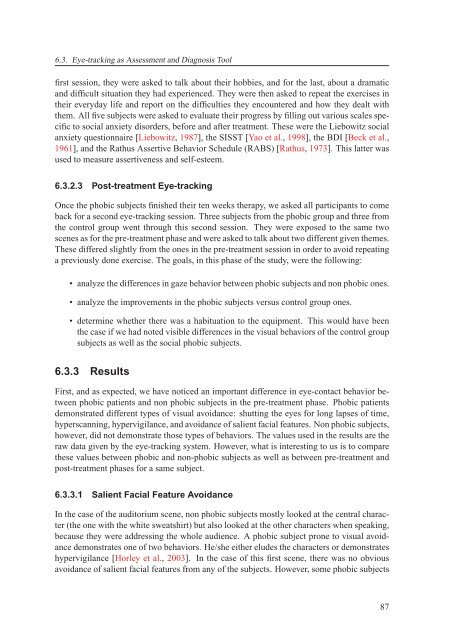Texte intégral / Full text (pdf, 20 MiB) - Infoscience - EPFL
Texte intégral / Full text (pdf, 20 MiB) - Infoscience - EPFL
Texte intégral / Full text (pdf, 20 MiB) - Infoscience - EPFL
You also want an ePaper? Increase the reach of your titles
YUMPU automatically turns print PDFs into web optimized ePapers that Google loves.
6.3. Eye-tracking as Assessment and Diagnosis Tool<br />
first session, they were asked to talk about their hobbies, and for the last, about a dramatic<br />
and difficult situation they had experienced. They were then asked to repeat the exercises in<br />
their everyday life and report on the difficulties they encountered and how they dealt with<br />
them. All five subjects were asked to evaluate their progress by filling out various scales specific<br />
to social anxiety disorders, before and after treatment. These were the Liebowitz social<br />
anxiety questionnaire [Liebowitz, 1987], the SISST [Yaoetal., 1998], the BDI [Beck et al.,<br />
1961], and the Rathus Assertive Behavior Schedule (RABS) [Rathus, 1973]. This latter was<br />
used to measure assertiveness and self-esteem.<br />
6.3.2.3 Post-treatment Eye-tracking<br />
Once the phobic subjects finished their ten weeks therapy, we asked all participants to come<br />
back for a second eye-tracking session. Three subjects from the phobic group and three from<br />
the control group went through this second session. They were exposed to the same two<br />
scenes as for the pre-treatment phase and were asked to talk about two different given themes.<br />
These differed slightly from the ones in the pre-treatment session in order to avoid repeating<br />
a previously done exercise. The goals, in this phase of the study, were the following:<br />
analyze the differences in gaze behavior between phobic subjects and non phobic ones.<br />
analyze the improvements in the phobic subjects versus control group ones.<br />
determine whether there was a habituation to the equipment. This would have been<br />
the case if we had noted visible differences in the visual behaviors of the control group<br />
subjects as well as the social phobic subjects.<br />
6.3.3 Results<br />
First, and as expected, we have noticed an important difference in eye-contact behavior between<br />
phobic patients and non phobic subjects in the pre-treatment phase. Phobic patients<br />
demonstrated different types of visual avoidance: shutting the eyes for long lapses of time,<br />
hyperscanning, hypervigilance, and avoidance of salient facial features. Non phobic subjects,<br />
however, did not demonstrate those types of behaviors. The values used in the results are the<br />
raw data given by the eye-tracking system. However, what is interesting to us is to compare<br />
these values between phobic and non-phobic subjects as well as between pre-treatment and<br />
post-treatment phases for a same subject.<br />
6.3.3.1 Salient Facial Feature Avoidance<br />
In the case of the auditorium scene, non phobic subjects mostly looked at the central character<br />
(the one with the white sweatshirt) but also looked at the other characters when speaking,<br />
because they were addressing the whole audience. A phobic subject prone to visual avoidance<br />
demonstrates one of two behaviors. He/she either eludes the characters or demonstrates<br />
hypervigilance [Horley et al., <strong>20</strong>03]. In the case of this first scene, there was no obvious<br />
avoidance of salient facial features from any of the subjects. However, some phobic subjects<br />
87

















